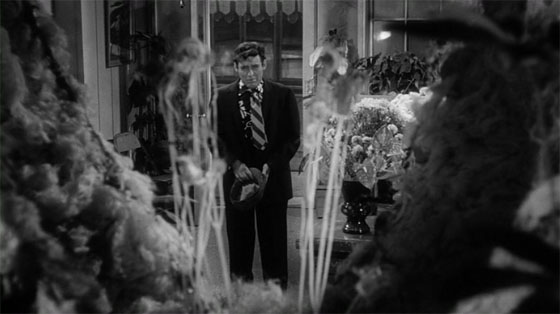 Famously, Roger Corman shot it in just over two days. It was written for Dick Miller, the Corman company player who had been the lead in War of the Satellites (1958) and A Bucket of Blood (1959), but he decided to take only a bit part – because he didn’t believe Corman could pull it off. Two days, $30,000, to be shot over the holidays (between Christmas and New Year’s), largely on one standing set but with an ambitious high-concept script. Maybe Miller was afraid that Corman would pull it off, and what it might entail to get there. He could be a slave-driver. As Corman writes in his 1990 autobiography, How I Made a Hundred Movies in Hollywood and Never Lost a Dime, “We started shooting at eight A.M., and at nine [assistant director Dick Dixon] announced between setups, ‘Let’s get going. We’re falling hopelessly behind schedule.'” The working title was The Passionate People Eater. The script, by Bucket of Blood writer Charles B. Griffith, concerned an employee of a flower store who breeds a giant plant which can only be sustained on human blood, and grows to monstrous proportions and a more greedy appetite. Though Corman granted three days of rehearsals, there was no time to fiddle with the script, and no pressure to blunt the content. It was a bizarre work of black humor (with a touch of black-and-white gore), and though it was appreciated by a gleeful audience at the premiere, after some middling box office it almost vanished into obscurity, this Little Shop of Horrors.
Famously, Roger Corman shot it in just over two days. It was written for Dick Miller, the Corman company player who had been the lead in War of the Satellites (1958) and A Bucket of Blood (1959), but he decided to take only a bit part – because he didn’t believe Corman could pull it off. Two days, $30,000, to be shot over the holidays (between Christmas and New Year’s), largely on one standing set but with an ambitious high-concept script. Maybe Miller was afraid that Corman would pull it off, and what it might entail to get there. He could be a slave-driver. As Corman writes in his 1990 autobiography, How I Made a Hundred Movies in Hollywood and Never Lost a Dime, “We started shooting at eight A.M., and at nine [assistant director Dick Dixon] announced between setups, ‘Let’s get going. We’re falling hopelessly behind schedule.'” The working title was The Passionate People Eater. The script, by Bucket of Blood writer Charles B. Griffith, concerned an employee of a flower store who breeds a giant plant which can only be sustained on human blood, and grows to monstrous proportions and a more greedy appetite. Though Corman granted three days of rehearsals, there was no time to fiddle with the script, and no pressure to blunt the content. It was a bizarre work of black humor (with a touch of black-and-white gore), and though it was appreciated by a gleeful audience at the premiere, after some middling box office it almost vanished into obscurity, this Little Shop of Horrors.
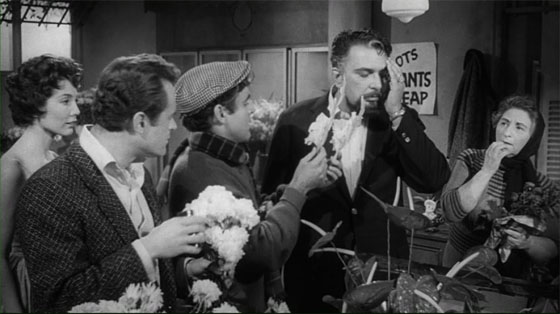
A typically chaotic day at Mushnick's: (l-r) Jackie Joseph, Dick Miller (salting carnations), Jonathan Haze, Mel Welles, Leola Wendorff
Griffith was often Corman’s ace in the hole. His versatile scripts could tackle any genre which the producer/director hastily tossed at him, from Westerns to science fiction to horror. But he had a sharp wit that, more often than not, surfaced in the finished film. His script for Death Race 2000 (1975), for example, worked as both an over-the-top work of ultraviolent action and a subversive dismantling of the genre; inevitably, the recent remake forgot to include the satire that was so key to the film’s purpose. But Griffith is still most famous for The Little Shop of Horrors, and justifiably so. The two-day filming constraint gave him an excuse to produce a completely irreverent script, holding nothing back. And Corman was on board with the script’s offbeat sensibility. He laments in his book that “a movie that wild and strange shouldn’t be only a moderate success. It should have been either a hit or a flat-out failure.” Griffith had originally envisioned a story about cannibalism, but felt that a man-eating plant would be more…palatable to audiences. The hero, mama’s boy Seymour (Corman regular Jonathan Haze, here channeling Jerry Lewis), works on Skid Row at “Mushnick’s Florist,” run by Eastern European immigrant Gravis Mushnick (TV actor Mel Welles). Signs hanging around the shop mimic Mushnick’s broken English: “40% Off From Everything,” “We Don’t Letting You Spend So Much,” and “Lots Plants Cheap.” Seymour pines for his beautiful but ditzy co-worker Audrey (stage comedienne Jackie Joseph), but Mushnick is growing tired of Seymour’s incompetence. When Seymour trims some flowers down to nothing in an effort to make them level, Mushnick threatens to fire him. “I didn’t mean it,” Seymour says, and Mushnick responds, “You didn’t mean it? You never mean it. You didn’t mean it when you put up the bouquet with the ‘Get Well’ card at the funeral parlor, and sent the black lilies to the old lady at the hospital.” Griffith’s back-and-forth patter throughout the film echoes that of an Abbott & Costello picture.
Seymour: But gee, Mr. Mushnick, don’t I always try to do what’s right? And I’m crazy about flowers. I like flowers almost as much as Audrey does.
Mushnick: Excellent, you’re fired.
Audrey: Why don’t you give him a chance to resurrect himself?
Mushnick: I give him a chance to quit.
Seymour: I ain’t gonna quit.
Mushnick: You’re a brave boy, you’re fired.
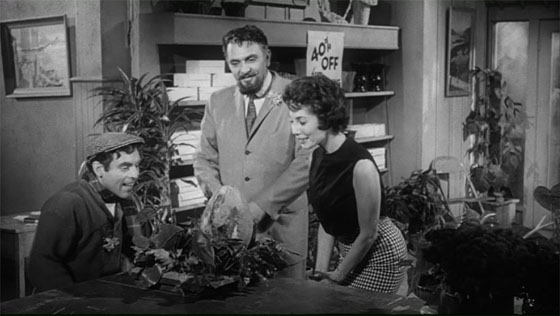
"It grows like a cold sore from the lip": Mushnick admires "Audrey Junior" alongside Seymour and Audrey.
When Seymour asks for one last chance – to bring a plant to the store which will boost business – Mushnick relents; he’s prompted to do so by a customer played by Dick Miller, who’s stopped into the shop to buy up some carnations so he can eat them as a delicacy. Seymour acquires some mysterious seeds from a Japanese gardener and produces a strange plant resembling a venus flytrap, which he grows in a coffee can. When he brings his prize back to the store, he calls it “Audrey Junior.” “You named it after me?” Audrey squeals. “That’s the most exciting thing anyone’s ever done to me.” (“You poor kid,” Miller deadpans.) But no matter what Seymour feeds the plant, it withers and begins to die. Only when he accidentally cuts his finger over Audrey Junior, letting a drop of blood fall into its mouth, does the plant begin to rally. It’s also begun to talk, moaning “Feed me,” and “I’m hungry,” when no one but Seymour is around to witness. No intelligence except for insatiable hunger is expressed by the plant, and soon Seymour has band aids on all of his fingers, nearly bled dry in his efforts to foster its growth. Mushnick couldn’t be happier: two high school girls, arriving just to see Audrey Junior, agree to spend their entire $2,000 budget for their Rose Bowl parade float in Mushnick’s shop. Under pressure to keep the plant alive, Seymour takes drastic measures. When he accidentally causes a man to stumble before an oncoming train, he decides to cut up the body and feed it in pieces to his grateful plant.
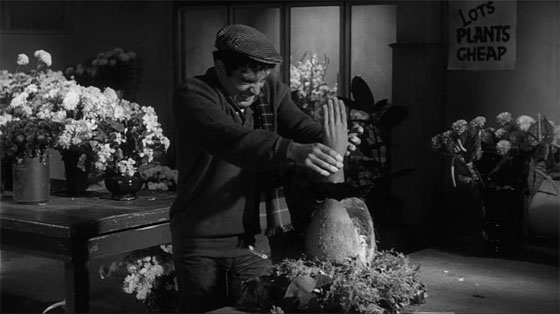
Audrey Junior enjoys a feeding: "That looks great!"
Narrating the film, incidentally, is Sgt. Joe Fink (Wally Campo), who is finally introduced in the middle of the picture meeting with Detective Frank Stoolie (Jack Warford). Just how hard-boiled are these cops? Well, this is how they small-talk:
Joe: How’s the wife, Frank?
Frank: Not bad, Joe.
Joe: Glad to hear it. The kids?
Frank: Lost one yesterday.
Joe: Lost one, eh? How’d that happen?
Frank (lighting a cigarette with a match): Playing with matches.
Joe: Those are the breaks.
Frank: Yeah, I guess so.
Turns out that man at the trainyard was an undercover cop, so they begin poking around Skid Row, eventually finding Mushnick’s store. Seymour’s plans seem to be in trouble, but the bodies keep piling up. Even Mushnick gets into the action, encouraging a burglar – played by writer Griffith – to step into Audrey Junior’s (now-massive) jaws. Seymour struggles to keep the plant’s true nature secret from Audrey, but it threatens their relationship: when he tries kissing her, the plant screams from behind them, “Feed me! I’m dying from hunger! I need some chow!” All of which she interprets as Seymour being the rudest date ever. But he can’t keep his secret for long, not when the blossoms on Audrey Junior bear an uncanny resemblance to the faces of its victims.
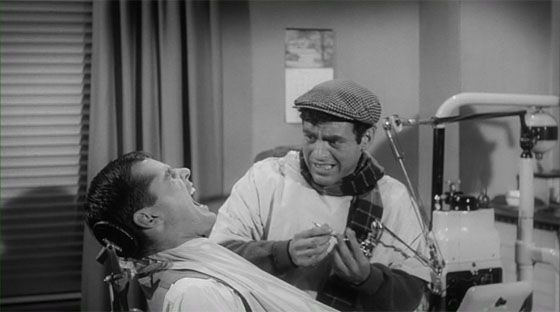
"Goody, goody, here it comes!" Patient Jack Nicholson eagerly awaits the dentist's drill operated by a reluctant Seymour.
Little Shop‘s most notorious scene involves a young (and unknown) Jack Nicholson, playing a masochistic dentist’s patient, first introduced eagerly reading PAIN Magazine in the lobby. Seymour has just murdered the sadistic dentist – after besting him in a duel of scalpel vs. drill – and is impersonating him until he gets a chance to abscond with the body. Nicholson announces, “I’d almost rather go to the dentist than anywhere, wouldn’t you?” while casually poking himself with the scalpel and tasting the blood. “Now, no novocaine. It dulls the senses.” After Seymour reluctantly drills right into the patient’s teeth, Nicholson screams with a voice cracking with ecstasy, “Oh my God, don’t stop now!” He then begs Seymour to pull some teeth, because why not? He leaves the office virtually toothless. This is ballsy stuff for a film of 1960, and its finale, in which Seymour achieves his ultimate fate, is as bleak as the rest of the comedy. The film was a quickie, but maybe that’s a good thing; no one had the time to rethink any of this.
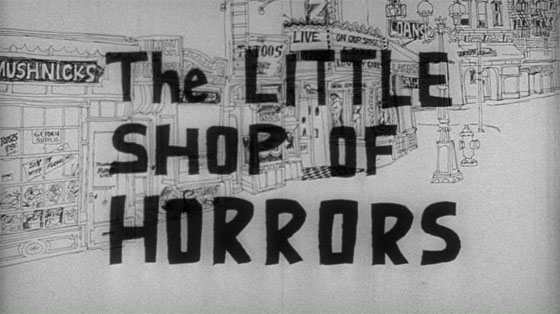 The Little Shop of Horrors benefits not just from its script but its performances. Everyone goes all-out in the fevered rush to complete the film with as few takes as possible. Mel Welles, as Mushnick, is a highight, along with Jackie Joseph, who radiates naïve innocence Gracie Allen-style. Myrtle Vail (A Bucket of Blood) is also quite good as Seymour’s perpetually ill mother, who guzzles dubious healing tonics of ninety-eight percent alcohol (she reads off the warning label, which offers such advice as, “If hit by a truck, see your physician”). Jonathan Haze gets off some nice moments as well, particularly when pretending to be a ventriloquist to a baffled Audrey. The film was saved from obscurity through frequent television airings throughout the 60’s and 70’s, eventually garnering a deserved cult following, who caught on to the fact that this particular B-movie was so very different from all the others. Please Don’t Eat My Mother!, a sleazy rip-off/remake, was released to the grindhouse circuit in 1973. In 1982, an off-Broadway musical based closely on the original film became an unexpected hit, spawning the well-known 1986 film adaptation, directed by Frank Oz and starring Rick Moranis, Ellen Greene, and Steve Martin (with many celebrity cameos). Corman’s 1960 version slipped into the public domain and has been released as frequently (and shoddily) on home video as Night of the Living Dead, usually top-billing Nicholson despite the brevity of his presence. Thankfully, Shout! Factory has offered the definitive version of the film on DVD as of this past summer: it’s finally available in anamorphic widescreen as a “bonus feature” on Trailers From Hell! Volume Two. And it looks great.
The Little Shop of Horrors benefits not just from its script but its performances. Everyone goes all-out in the fevered rush to complete the film with as few takes as possible. Mel Welles, as Mushnick, is a highight, along with Jackie Joseph, who radiates naïve innocence Gracie Allen-style. Myrtle Vail (A Bucket of Blood) is also quite good as Seymour’s perpetually ill mother, who guzzles dubious healing tonics of ninety-eight percent alcohol (she reads off the warning label, which offers such advice as, “If hit by a truck, see your physician”). Jonathan Haze gets off some nice moments as well, particularly when pretending to be a ventriloquist to a baffled Audrey. The film was saved from obscurity through frequent television airings throughout the 60’s and 70’s, eventually garnering a deserved cult following, who caught on to the fact that this particular B-movie was so very different from all the others. Please Don’t Eat My Mother!, a sleazy rip-off/remake, was released to the grindhouse circuit in 1973. In 1982, an off-Broadway musical based closely on the original film became an unexpected hit, spawning the well-known 1986 film adaptation, directed by Frank Oz and starring Rick Moranis, Ellen Greene, and Steve Martin (with many celebrity cameos). Corman’s 1960 version slipped into the public domain and has been released as frequently (and shoddily) on home video as Night of the Living Dead, usually top-billing Nicholson despite the brevity of his presence. Thankfully, Shout! Factory has offered the definitive version of the film on DVD as of this past summer: it’s finally available in anamorphic widescreen as a “bonus feature” on Trailers From Hell! Volume Two. And it looks great.









